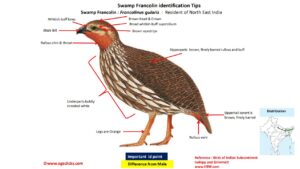
Swamp Francolin Francolinus gularis
Etymology:
- Francolinus : Italian name Franci –Free Fowl, because the common people were forbidden to take them as the royalty had granted them freedom of living
- Gularis : Latin word gula –throat { throated}
Vernacular Names : Bi: Bhil titri, Ben: Kyah, Khyr, Kaijah, Ass: Koi, Koi sorai, Koira, Hoi koli, B’ desh: Bheel teetar, Gul teetar, Hindi: Kaya teetar
Distribution in India: Resident of Nepal eastwards to Assam.
Description: Size of 36–38 cm; weight of male 510 g. It is the largest francolin on Indian Subcontinent, with broad whitish-buff lores and supercilium, boldly white-streaked white underparts except rufous vent, and overall brown upperparts finely barred rufous and buff. It has chestnut outer tail feathers and primaries are conspicuous in flight. The Iris is brown, bill is black, legs are orange-yellow to red (brightest in breeding male). The female is similar to male but lacks spur and has duller tarsus. The juvenile is like adult but is duller, with buffier throat and has brown, rather than black, edges to streaking on underparts.
Habitat: It is found in wet grasslands, tall, dense grassland near marshy and swampy areas, in sugarcane plantations around standing water in some areas, and in paddyfields. It is found it is found up to 1200 m.
Food habits: It eats Seeds of weeds and cereals, mustard, rice and other crop shoots, bulbs and tubers; also, insects. It emerges from tall grassland and cultivation, especially sugarcane, to forage on tracks with very short grass and around marshes in early morning and late afternoon. It sometimes wades in shallow water.
Breeding habits: They breed Mar to May. They are monogamous; usually encountered in pairs, occasionally groups of four adults. The nest is a more rudimentary structure; comprises a relatively deep cup of grass and weeds. The nest is placed amongst reeds standing in water, in which case constructed from reeds, at marsh edge. They lay a clutch of 3–4 eggs. The eggs are pale buff, blotched reddish. The incubation and nest construction is done by female alone, but male helps tend chicks.